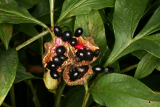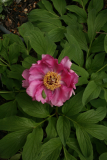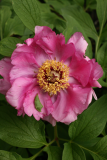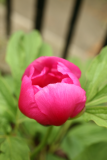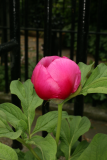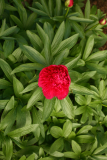Additional notes (click to expand)
Commemorative
The glorious peony, commemorates Paeon, physician to the gods of ancient Greece, who enjoyed the best private practice of the era. Homer’s Iliad v. 401 and 899 (c. 800 BC) provides further details (Murray, 1924). The name Paeon came to be associated as being Apollo, Greek god of healing, poetry, the sun and much else, and father of Aesculapius/Asclepias. Hesiod, the greatest Greek author after Homer, about a century later, clearly regarded them as separate deities, viz:
If neither Phoebus Apollo does save us from death, nor Paean who knows remedies for everything.
The Mycenaean Greeks of the late Bronze Age (1600–1100 BC) worshipped a god of healing called Paiawon, ‘a divinity with a formidable knowledge of herbs and drugs ...’ (Graf, 2009), and Apollo was not known. Paiawon’s cult disappeared after the collapse of the Mycenaean world. The fusion of Paiawon/Paeon and Apollo occurred much later as both being names for the god of healing.
Theophrastus (c. 300 BC), repeated by Pliny (AD 79), wrote that if a woodpecker saw one
collecting peony seed during the day, it would peck out one’s eyes, and (like mandrake) the roots had to be pulled up at night by tying them to the tail of a dog, with the added warning that one’s ‘fundament might fall out’ (anal prolapse) if one cut the roots with a knife. Theophrastus, I am glad to say, thought this ‘far-fetched’, as did Pliny, viz: ‘all this, however, I take to be so much fiction, most frivolously invented to puff up their supposed marvellous properties’.
Oakeley, Dr. Henry. (2012). Doctors in the Medicinal Garden. Plants named after physicians. Royal College of Physicians.
link
Horticulture
The European Paeonia officinalis, a hardy perennial of the Paeoniaceae family, and the double form ‘Rubra Plena’ grow happily in the Medicinal Garden in a herbaceous border in dappled shade. The beautiful dissected foliage, crimson flowers from April to June and striking seed pods make it a welcome addition to the garden. Both this and P. suffruticosa, which we also grow, require deep, welldrained soil. The soil was prepared thoroughly before planting and the site was chosen carefully to avoid morning sun, which can cause damage after frost. We mulch annually with well-rotted manure in spring, avoiding the crowns. Otherwise, they are best left undisturbed. (Clare Beacham)
Oakeley, Dr. Henry. (2012). Doctors in the Medicinal Garden. Plants named after physicians. Royal College of Physicians.
link
Medicinal
Paeonia officinalis L. Paeoniaceae, European Peony, 'Flore Pleno' , the double form. Distribution: Europe. The peony commemorates Paeon, physician to the Gods of ancient Greece (Homer’s Iliad v. 401 and 899, circa 800 BC). Paeon, came to be associated as being Apollo, Greek god of healing, poetry, the sun and much else, and father of Aesculapius/Asclepias. Theophrastus (circa 300 BC), repeated by Pliny, wrote that if a woodpecker saw one collecting peony seed during the day, it would peck out one’s eyes, and (like mandrake) the roots had to be pulled up at night by tying them to the tail of a dog, and one’s ‘fundament might fall out’ [anal prolapse] if one cut the roots with a knife. Theophrastus commented ‘all this, however, I take to be so much fiction, most frivolously invented to puff up their supposed marvellous properties’. Dioscorides (70 AD, tr. Beck, 2003) wrote that 15 of its black seeds, drunk with wine, were good for nightmares, uterine suffocation and uterine pains. Officinalis indicates it was used in the offices, i.e. the clinics, of the monks in the medieval era. The roots, hung round the neck, were regarded as a cure for epilepsy for nearly two thousand years, and while Galen would have used P. officinalis, Parkinson (1640) recommends the male peony (P. mascula) for this. He also recommends drinking a decoction of the roots. Elizabeth Blackwell’s A Curious Herbal (1737), published by the College of Physicians, explains that it was used to cure febrile fits in children, associated with teething. Although she does not mention it, these stop whatever one does. Parkinson (1640) also reports that the seeds are used for snake bite, uterine bleeding, people who have lost the power of speech, nightmares and melancholy.
Oakeley, Dr. Henry. (2012). Doctors in the Medicinal Garden. Plants named after physicians. Royal College of Physicians.
link
Other use
Notes by Henry Oakeley from Lindley's 'Flora Medica' (1838): Lindley tells us that the genus may have been used in medicine since the time of Dioscorides (c. 40-90 AD), the seeds being emetic (making one vomit) and purgative, and the roots reputedly antispasmodic (preventing intestinal colic). The Latin word, officinalis, means ‘sold in shops’ and indicates that the plant was regarded as having medicinal properties. Paeon was the physician to the gods in the mythology of ancient Greece
Lindley, John. (1838). Flora Medica, Longman, Orme, Brown, Green & Longmans
Geographical distribution
- Europe, Middle Europe, Hungary
- Europe, Middle Europe, Switzerland
- Europe, Southeastern Europe, Albania
- Europe, Southeastern Europe, Italy
- Europe, Southeastern Europe, Romania
- Europe, Southeastern Europe, Yugoslavia
- Europe, Southwestern Europe, France
- Europe, Southwestern Europe, Portugal
- Europe, Southwestern Europe, Spain
Podcast
Paeonia officinalis L.
Family: PAEONIACEAEGenus: Paeonia
Species: officinalis L.
Common names: Peony
Pharmacopoeia Londinensis name: Poeonia
Distribution summary: C. & S. Europe
Habit: Perennial
Hardiness: H6 - Hardy; very cold winter
Habitat: Rocky slopes, scrub & light woodland
Garden status: Currently grown
Garden location: Europe & Mediterranean (E)
Flowering months: May
Reason for growing: Commemorative, medicinal, traditional herbal registration
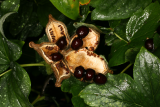

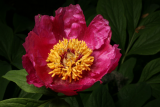

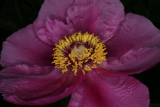



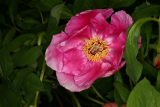
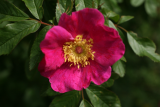
 (a cultivar).JPG)
 seeds.JPG)
